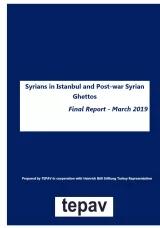Syrians in Istanbul and Post-war Syrian Ghettos
Executive Summary
Ghetto is a concept that portrays the parts of a city which have not been integrated with or caused to be segregated from other living spaces. The concept also describes an urban area where the social and residential factors intersect through clustering formed by idiosyncratic lifestyles and sociocultural affinities where homogenous areas are created, promoting social and residential segregation within the heterogeneous structure of the city.
Until the 1980s, the ghetto concept was rather a product of ethnical, religious, and social segregation. Thereafter the concept was used in a larger context than that of its original meaning. The ghetto concept became a referance to the socioeconomically poor parts of a city deprived of infrastructure and any social facilities. Then by the 2000s, closed communities/secure housing estates, which emerged as a part of the consumption culture and an urban segregation model, became the modern or rich ghettos. This shift in conceptualizing ghetto, especially after 1980, drpped the referance to the akin nature of ethnical, religious, sectarian, and cultural homogeneities, and turned to a symbol and a tool of class separation.
Beginning 2010 a number of uprisings broke out in the Middle East and North Africa. Encountring the urisings triggered waves of forced displacement, the largest of which concerns the 5.6 million Syrians who are scatered in the neighboring counties. The relocation of Syrians, however, brought along a new feature: post-war ghettos, namely in Turkey. The Economic Policy Research Foundation of Turkey in cooperation with Heinrich Böll Stiftung Turkey Representation undertook the responsibility of navigating the post-war ghetto phenomenon in three districts of Istanbul: Fatih, Sultanbeyli, and Sultangazi
The primary purpose of the study is to identify the reasons behind the ghettoization process in the aforementioned districts, highlight the socioeconomic dynamics in the pilot destinations, underline the Level of interaction between the newarrivals and the hosting communities, showcase the role of stakeholders, mainly localities and Non-Govenmnetal Organizations (NGOs), in the emergence of the ghettos, and propose a set of policy recommendation on the prospects of post-war ghettoization at a the local and national levels.
The results of the study are based on field visits where in-depth interviews took place with 370 individuals to verify the presence of the five basic parameters of ghettoization: i) isolated area, ii) residential segregation, iii) homogeneous relations, iv) social exclusion, and v) population density, which are present in both Fatih and Sultangazi, effectively turning certain areas within the districts into post-war ghettos. On the other hand, the characteristics of ghetto are absent in Sultanbeyli, allowing a space of comparision while considering the historical formation and economic structures of the three districts.
Product details
Table of contents
Table of Contents ............................................................................................................................ 3
Executive Summary ......................................................................................................................... 4
- Introduction ...................................................................................................................................... 6
II. General Evaluation ................................................................................................................ 7
The Ghetto Concept and Ghettoization in the Literature ..................................................... 7
The Ghetto Concept Reinterpreted in 1980s and Later ........................................................ 9
The Basic Characteristics and Distinctive Variables of the ‘Ghetto’ Concept ........... 11
III. Discussions on Ghetto in Exemplary Field Studies in Turkey............................................. 14
Balat Jewish Ghetto/Istanbul ................................................................................................... 16
Sulukule Romany Ghetto/Istanbul.......................................................................................... 18
A Sectarian Ghetto: Gazi Quarter/Istanbul ............................................................................... 20
Modern ghettos: Mavişehir’s Closed Luxury Housing Estates/ İzmir ........................... 21
Post-war Ghetto: Önder Quarter/Ankara .................................................................................. 22
IV. Post-war Syrian Ghettos in Istanbul .................................................................................... 30
Syrians in Turkey ..................................................................................................................... 30
Syrians in Istanbul ............................................................................................................. 33
Findings of the Post-war Syrian Ghettos in Istanbul Project Field Research ............ 35
Research Findings Regarding Demographics ....................
Research Findings Regarding Ghettoization.........................................................................37
Conclusion and General Evaluation ..................................................................................... 73
Policy Suggestions ............................................................................................................ 76
ANNEXES .......................................................................................................................... 80
References ............................................................................................................... 88
